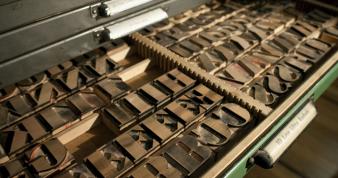Wood Type - A Selection of Specimens at the Cary

A Selection of Specimens at the Cary
Big Type
There has always been a need for communicating with large letters. Take for example, monumental inscriptions carved into an edifice read from below or afar, or hand-lettered signs beckoning from shop windows. Carving and painting are relatively simple tasks for the human hand to scale larger, but printing in large sizes was limited by the method of type manufacture. Because casting type larger than 20 lines or 240 point often produced unprintable letters with concave faces caused by uneven cooling of the type metal in its mould. Wood was a much lighter and more forgiving substance to work for large type, but early on all characters had to be carved by hand.
Enter New Yorker Darius Wells who engineered the lateral router in the 1820s, the machine that could mass-produce wood type letters. And so an American industry was born in the manufacture of large relief block wooden type that flourished into the twentieth century. This movement in printing history produced some of the most interesting letterforms conceived before digital typefounding, which continue to inspire and delight us even today.
This online exhibition includes images of some important nineteenth century wood type specimens found in the Cary, as well as imaginative contemporary work produced with wood type as its medium. These items were featured in a 2013 exhibition on the premises of the Cary Collection, that also highlighted our holdings of over 500 wood type printing fonts—thousands of characters—that are being restored by volunteers in a program we call “Adopt-a-Font.”
Amelia Hugill-Fontanel
RIT Cary Collection


































